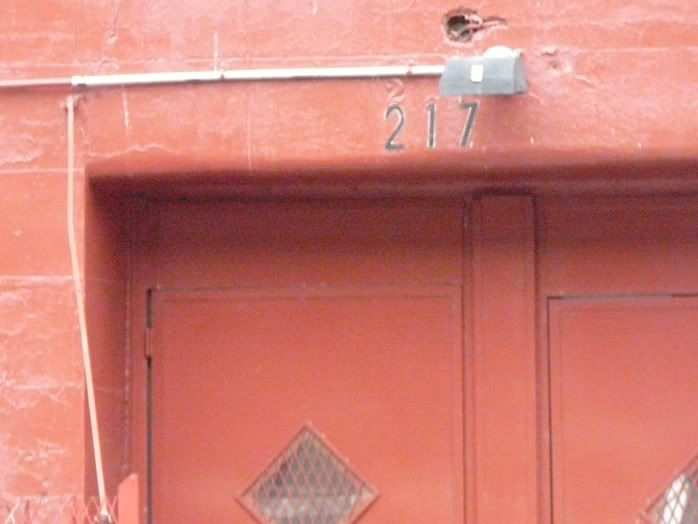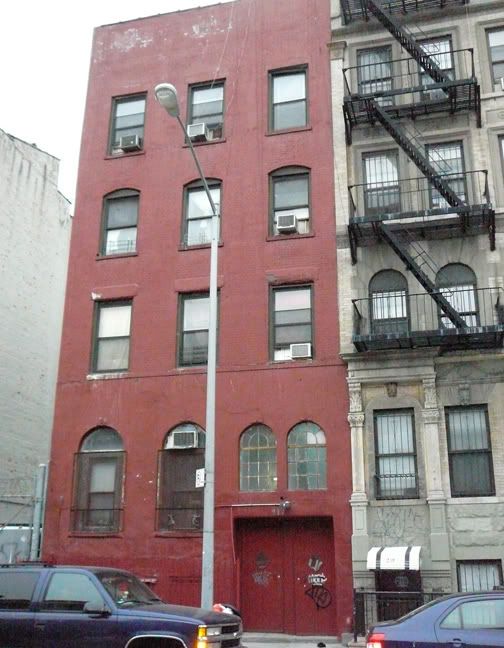

According to Ron Roth, the infamous Lepke lived here sometime between 1900-1910. Lepke was mentioned previously with a slide show
from wikipedia
Louis "Lepke" Buchalter (12 February 1897 – 4 March 1944) was a Jewish- American mobster of the 1930s. He is the only major mob boss ever to have been executed by state or federal authorities for his crimes.
Born in 1897 to Eastern European immigrants on the Lower East Side of Manhattan, Buchalter took on the nickname "Lepke" at an early age. The name was an abridgement of the affectionate diminutive "Lepkeleh" ("Little Louis" in Yiddish) his mother had called him when he was a small boy. By 1919, at the age of only 22, he had already served two prison terms.
Upon his release, he teamed up with his childhood friend, Jacob "Gurrah" Shapiro, gradually gaining control of the garment industry unions on the Lower East Side. He used the unions to threaten strikes and demand weekly payments from factory owners while simultaneously dipping into union bank accounts. His control of the unions later evolved into a general protection racket, extending into such areas as bakery trucking. The unions were an extremely profitable venture for him, and he kept a firm hold on them even after becoming an important figure in the organized crime world.
In the early 1930s, Charles "Lucky" Luciano, Lepke, and John "Johnny The Fox" Torrio, (the former Chicago boss and mentor of Al Capone), formed a loose alliance. To take care of any problems that arose, Luciano's associates Benjamin "Bugsy" Siegel and Meyer Lansky formed Murder, Inc. Originally a band of Brooklyn killers, they were highly effective and eventually used to fulfill most murder contracts. Control of the group soon passed to Lepke and Albert "Mad Hatter" Anastasia, as Siegel and Lansky had larger concerns to deal with. Murder, Inc., the name given to it by the media in the 1940s, was credited with carrying out numerous contract killings throughout the country, including the slaying of Dutch Schultz.
As many as a hundred corpses have been attributed to Lepke[citation needed]. Some of the hitmen at Lepke's disposal included Abe "Kid Twist" Reles, Seymour "Blue Jaw" Magoon, Frank "Dasher" Abbandando, Harry "Happy" Maione, Albert "Tick-Tock" Tannenbaum, and Harry "Pittsburgh Phil" Strauss (known as "Pittsburgh Phil" despite his having no known connection to that city). The killing of Dutch Schultz on 23 October 1935 was a major killing for the group, as was the murder of Louis "Pretty" Amberg the same day.
Buchalter's downfall began in the mid-1930s when he went on the run from both the FBI, who wanted to arrest him on a narcotics charge, and from New York City special prosecutor Thomas E. Dewey, who wanted him tried for his syndicate activities. He was tricked by a childhood friend into surrendering to the federal government in exchange for his not being turned over to Dewey. Buchalter was sent to Leavenworth Federal Penitentiary in Kansas on a 14 year term for narcotics trafficking. The sentence was later extended to 30 years on account of Buchalter's involvement in union racketeering.
Even more serious legal problems and consequences followed for Buchalter in 1940. That year, the state of New York indicted him for a murder committed over four years earlier, on 13 September 1936. On Sunday morning, a crew of Murder, Inc. killers, acting on Buchalter's orders[citation needed], had gunned down Brooklyn candy store owner Joseph Rosen. Rosen was a former garment industry trucker whom Buchalter had forced out of business. He had aroused Buchalter's ire by failing to heed Lepke's warnings to keep quiet and leave town. Rosen allegedly began threatening to expose Lepke and his vast crime operations to special prosecutor Thomas E. Dewey.
Buchalter's order for the Rosen hit had been overheard by Abe Reles, who turned informant for New York State in 1940 and fingered Buchalter for four murders. Brought back from Leavenworth to Brooklyn to stand trial for the Rosen slaying, Buchalter's position was worsened by the testimony of Albert Tannenbaum. Four hours after they were handed the case, the jury arrived at a verdict at 2:00 a.m. on 30 November 1941, finding Buchalter guilty of first degree murder. The penalty at the time for such a crime in the state of New York was death by electrocution. Also convicted and sentenced to death for the same crime were two of Buchalter's lieutenants who had participated in the planning and carrying out of the Rosen murder, Emanuel "Mendy" Weiss, and Louis Capone (no relation to Al).
Buchalter's conviction took place in December 1941, and the New York Court of Appeals, upon review of his case, upheld his conviction and death sentence in October 1942. At the time, Buchalter was serving his racketeering sentence at Leavenworth Federal Prison, and New York state authorities demanded that he be turned over to them for execution. Buchalter resisted, managing to remain in Kansas and out of New York's hands until finally extradited in January 1944. Buchalter and his lieutenants Weiss and Capone were electrocuted within minutes of each other at New York's Sing Sing prison on 4 March 1944.
Many people are aware that the Gambino Family’s base of operations was (and probably still is) New York City’s Garment Center. Few know that the Gambinos inherited the garment rackets from a Jewish gangster—Louis (Lepke) Buchalter, considered by some historians to be the wealthiest and most powerful mob boss in American organized crime history.
Lepke was born on New York’s Lower East Side in 1897. His father ran a successful hardware store, and one of his brothers became a doctor. But Lepke was drawn to the dark side. His first crime boss was Dopey Benny Fein, who ran a large, successful violence-for-hire racket in the Garment District. Buchalter and his pal, Jacob (Gurrah) Shapiro, later associated themselves with Jacob (Little Augie) Orgen, Benny’s successor. Lepke and Gurrah took over after murdering Little Augie. But they didn’t simply replace Augie as thugs-for-hire—like Jewish Kelly Girls with muscle. Instead, they saw themselves as integrating and harmonizing forces across both management and labor sides of an industry in which violence and turmoil were ceaseless. Lepke used the model of the turn of the century “Robber Barons,” as well as military tactics, to gain control:
Buchalter looked for weak links in the industry’s chain of power. His first move was against the furriers’ unions, weakened by the Depression. He seized control of the rabbit furriers’ union, which was still viable, then moved in on all the others. By the end of his first year, both unions and management were paying him $5 million annually for peace.
He then attacked the garment unions. His target was the cutters’ union, small (less than 1,000 members) but highly strategic: no cutters, no patterns; no patterns, no dresses and suits. All the other unions shortly fell under his thumb. Then, in an unprecedented move for a labor racketeer, he muscled his way into controlling positions in three of the Garment District’s biggest manufacturing companies. Now Lepke had a commanding position in both labor and management. He recognized that trucking was crucial to the industry, so he knocked over the trucking companies and their unions.
By the mid-Thirties, Lepke controlled everything that was made in, and that went in and out of, the Garment District. Sidney Hillman, head of the Amalgamated Clothing Workers Union and President Roosevelt’s top labor adviser (“Clear it with Sidney” was one of FDR’s most familiar phrases) allegedly paid Lepke $5,000 a week for peace. Lepke’s control was so pervasive that the first Federal charge against him, in 1936, was for violating the Sherman Antitrust Act by operating a “combination in restraint of trade”—a distinction previously awarded to the likes of U.S. Steel and Standard Oil.
Like a true Robber Baron, Lepke had a zeal for conglomeration. He knocked over the handbag industry, since handbags were accessories to the dresses he controlled in the Garment Center. Pursuing several clothing companies that had moved to Brooklyn to escape his clutches, he saw that the bakers’ union was ripe for takeover. Within weeks, every loaf of bread sold in New York City was paying a “Lepke tax.” He grabbed a big piece of the movie industry rackets without ever stepping foot in Hollywood: he forced his way into the movie projectionists’ union, another small but strategically placed group—no projectionists, no movies; no movies, dark studios.
Buchalter’s zeal for conglomeration proved to be his undoing. To provide an unlimited source of muscle needed to enforce his will, he reached into the Brownsville section of Brooklyn, the most densely populated neighborhood in America and the most concentrated source of Jewish thugs. There he (not, as myth has it, Albert Anastasia, Bugsy Siegel or Meyer Lansky) formed “Murder, Inc.,” headquartered in Midnight Rose’s candy store (where Yours Truly worked as a teenager). In another innovation, Lepke paid his killers weekly salaries, rather than commissions for various jobs, which would have encouraged them to work for the highest bidders. Ever the businessman, Lepke saw that Murder, Inc. was a cost center. So he endeavored to turn it into a profit center by hiring out his thugs to others. One of his biggest customers was Albert Anastasia, boss of the Ocean Hill section of the neighborhood. Albert A also provided Lepke with some Mafia killers.
With so much blood on their hands (as many as 1,000 killings according to some accounts), Murder, Inc. came under intense scrutiny from law enforcement. Charged with several murders, two of the group’s top lieutenants, Abraham (Kid Twist) Reles and Allie (Tick-Tock) Tanenbaum, turned state’s evidence in 1939 and provided thousands of pages of testimony, as well as details of dozens of murders, several of which implicated Lepke directly. Reles mysteriously “fell” out of a sixth-floor hotel window while in police custody, earning him the sobriquet, “the canary who could sing but couldn’t fly.” Lepke took it on the lam, hiding out in Brooklyn for more than a year while his business went to hell.
Finally, three of Lepke’s underworld pals—Albert A, Lansky and Abner (Longy) Zwillman, convinced him to surrender on Federal drugs and racketeering charges, which they assured him would result in no more than a five- or six-year sentence and protect him from New York’s special prosecutor, Thomas E. Dewey, who wanted to send him to the electric chair for his murders. Lepke met with famed radio and newspaper columnist Walter Winchell, who drove him to a car containing FBI chief J. Edgar Hoover, to whom he surrendered. He was convicted on the Federal raps in 1941, and sentenced to 14 years in Leavenworth.
However, Lepke was so big that he had become a factor in Presidential politics. Dewey (who was to be the GOP Presidential candidate in 1944 and 1948) charged that FDR was being “soft” on Lepke to keep him quiet about his relationship with Sidney Hillman. The Justice Department obligingly turned Lepke over to Dewey, who prosecuted and convicted him for murder. Lepke was executed in 1944, the first and only mob boss to die in the chair. The Mangano/Anastasia Mafia family took over his labor and trucking rackets, which to this day are a Gambino stronghold.


























No comments:
Post a Comment